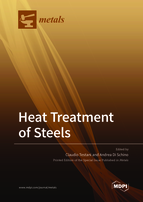Heat Treatment of Steels
A special issue of Metals (ISSN 2075-4701). This special issue belongs to the section "Metal Casting, Forming and Heat Treatment".
Deadline for manuscript submissions: closed (30 April 2021) | Viewed by 45876
Special Issue Editors
Interests: steels; microstructure; properties; additive materials
Special Issues, Collections and Topics in MDPI journals
Interests: light alloys; titanium alloys; aluminium alloys; ODS steels; thermal treatments powder metallurgy; additive manufacturing; forging; extrusion; hot isostatic pressing; superplastic forming
Special Issues, Collections and Topics in MDPI journals
Special Issue Information
Dear Colleagues,
Steels represent a quite interesting material family, both from a scientific and commercial point of view, following many applications they can be devoted to. Following that, it is therefore essential to deeply understand the relations between properties and microstructure and how to drive them via a specific process. Despite their diffusion as a consolidated material, many research fields are active regarding new applications. In this framework in particular, the role of heat treatments in obtaining even complex microstructures is still quite an open matter, also thanks to the design of innovative heat treatments.
The Special Issue scope embraces interdisciplinary work covering physical metallurgy and processes, reporting on experimental and theoretical progress concerning microstructural evolution during heat treatments of steels.
Prof. Dr. Andrea Di Schino
Dr. Claudio Testani
Guest Editors
Manuscript Submission Information
Manuscripts should be submitted online at www.mdpi.com by registering and logging in to this website. Once you are registered, click here to go to the submission form. Manuscripts can be submitted until the deadline. All submissions that pass pre-check are peer-reviewed. Accepted papers will be published continuously in the journal (as soon as accepted) and will be listed together on the special issue website. Research articles, review articles as well as short communications are invited. For planned papers, a title and short abstract (about 100 words) can be sent to the Editorial Office for announcement on this website.
Submitted manuscripts should not have been published previously, nor be under consideration for publication elsewhere (except conference proceedings papers). All manuscripts are thoroughly refereed through a single-blind peer-review process. A guide for authors and other relevant information for submission of manuscripts is available on the Instructions for Authors page. Metals is an international peer-reviewed open access monthly journal published by MDPI.
Please visit the Instructions for Authors page before submitting a manuscript. The Article Processing Charge (APC) for publication in this open access journal is 2600 CHF (Swiss Francs). Submitted papers should be well formatted and use good English. Authors may use MDPI's English editing service prior to publication or during author revisions.
Keywords
- Steel
- Heat treatments
- Microstructure
- Mechanical properties
- Q&P







